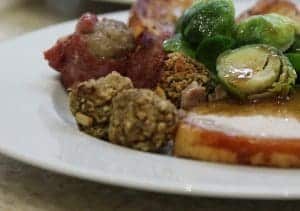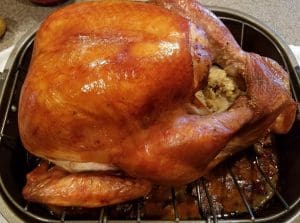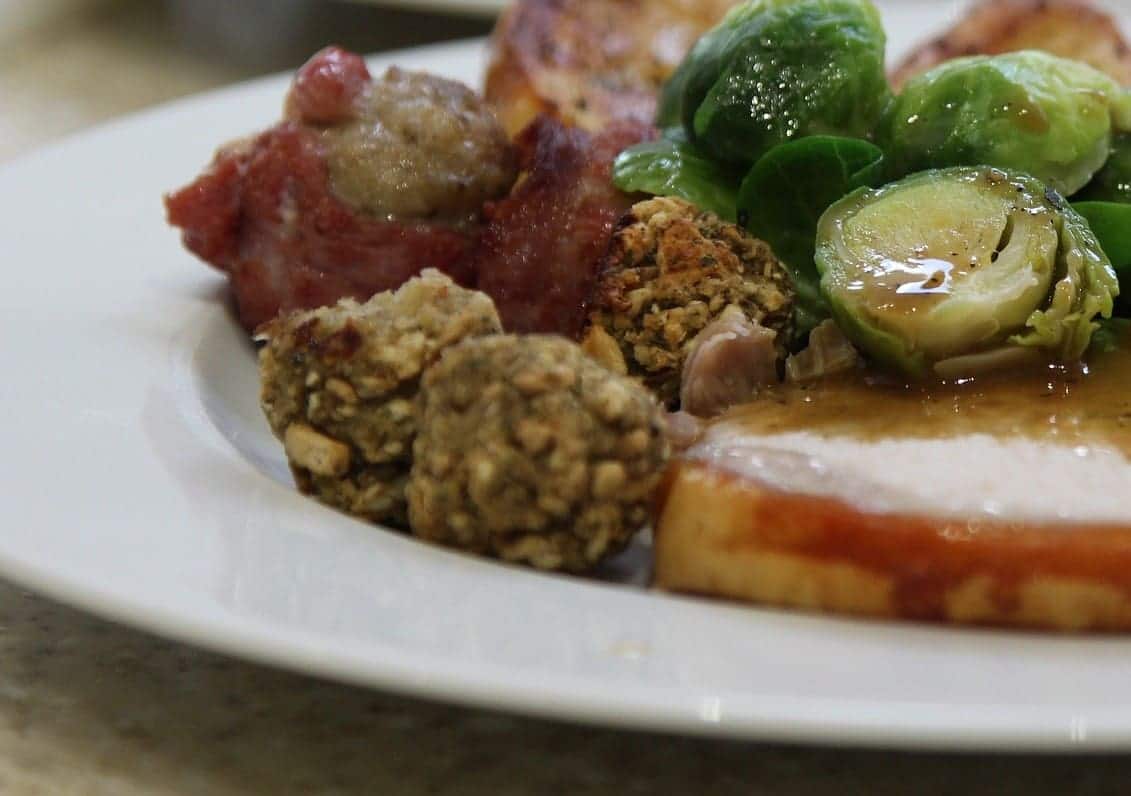Christmas is a time of joy, celebration and indulgence, and nothing says indulgence more than a hearty roast dinner with all the trimmings. One of the most essential and delicious components of a festive feast is the Christmas stuffing – a savoury mixture of bread, herbs, spices and other ingredients that is used to fill the cavity of a bird or cooked separately in a baking dish.
Stuffing adds flavour, moisture and texture to your meal, and can be adapted to suit different tastes and preferences.
Here, the Christmas.co.uk team explore the history of why we eat stuffing at Christmas, along with easy-to-follow recipes to create your own tasty wonders.
What is stuffing and why is it popular?
 For those who don’t know, stuffing is an edible mixture that is usually made with breadcrumbs, onion, celery, spices, herbs and sometimes other ingredients such as sausage meat, nuts, dried fruits or chestnuts.
For those who don’t know, stuffing is an edible mixture that is usually made with breadcrumbs, onion, celery, spices, herbs and sometimes other ingredients such as sausage meat, nuts, dried fruits or chestnuts.
It is traditionally used to stuff the body cavity of poultry, such as turkey, chicken or goose, before roasting, to help retain moisture and add flavour.
However, stuffing can also be cooked separately in a baking dish or shaped into balls. But which one to use? If you like crispy stuffing with your roast dinner, then cook separately, if you are looking for flavour but no crispy edges, then cook yours in the bird.
For many of us, stuffing is popular because it complements the meat and gravy served up for dinner and provides a satisfying contrast of textures and tastes.
Stuffing is also versatile and variants could be made with different types of bread, such as white, wholemeal, or sourdough, and different seasonings, such as sage, thyme, rosemary or parsley.
What is the history of stuffing?
The origin of stuffing is not clear, but it is likely that people have been stuffing animals with other foods for centuries. The earliest written evidence is in a Roman cookbook entitled Apicius De Re Coquinaria.
It has recipes for stuffed chicken, pig, hare and dormouse, using ingredients such as vegetables, herbs, nuts, spelt (a type of grain), plus brains, liver and other organs.
The word ‘stuffing’ comes from the Old French word ‘estoffe’, meaning ‘to fill up’, which was later anglicised to ‘stuff’.
How easy is it to make stuffing at home?
Making your own stuffing at home is not difficult at all. You only need a few basic ingredients and some simple steps. For traditional sage and onion stuffing you’ll need one large onion and 180g of fresh breadcrumbs (that’s around four slices of medium sliced bread). Then add one tablespoon each of oil, fresh or dried sage, one bay leaf and one clove of garlic and a large fresh egg.
Here is a general guide on how to make stuffing:
- Preheat your oven to 180°C/160°C fan/gas mark 4.
- Cut some bread – it can be fresh or stale – into small cubes and spread them on a baking sheet. Bake for about 15 minutes or until lightly toasted. Others simply use fresh bread and place it in a food processor to create the crumbs.
- Take a large frying pan or skillet over medium-high heat, melt some butter and cook some chopped onion and celery until soft. Add some broth and seasonings of your choice and bring to a boil.
- In a large bowl, toss the bread cubes with the onion mixture until well coated. Stir in some beaten eggs to bind the mixture together.
- Transfer the stuffing to a greased baking dish or stuff it into the cavity of your bird. If baking separately, cover with foil and bake for about 30 minutes or until golden and cooked through.
It is worth noting that you don’t need to go overboard when adding seasonings – as mentioned, one tablespoon should be enough. Sage can be an overpowering choice so you could opt to use mixed or thyme instead.
oooOooo
Sage and Onion Stuffing – How to Make
This is an interesting video from Pinch of Mint that shows just how easy it is to make your stuffing at home for Christmas.
Here, you start with sausage meat, add breadcrumbs and diced onion.
He heats up a frying pan, adds butter, onion, salt for four minutes and then adds a diced Bramley apple.
Then, leaving the pan to cool, he chops sage and adds it to the sausage meat, adds the cooled onions and apple and then mixes it together.
The finished product is either rolled into stuffing balls or pressed into a dish for baking.
oooOooo
Tips and advice for different types of stuffing
Depending on what kind of meat you are serving for your Christmas dinner, you may want to choose a different type of stuffing to match it. Here are some suggestions for different types of stuffing:
 For turkey: Turkey is the classic choice for Christmas dinner in many countries, and it goes well with a variety of stuffing. Some popular options are sage and onion stuffing, cranberry and sausage stuffing, chestnut and bacon stuffing, or apricot and pecan stuffing.
For turkey: Turkey is the classic choice for Christmas dinner in many countries, and it goes well with a variety of stuffing. Some popular options are sage and onion stuffing, cranberry and sausage stuffing, chestnut and bacon stuffing, or apricot and pecan stuffing.
For beef: Beef is another popular option for Christmas dinner, especially roast beef or prime rib. For beef, you may want to choose a more robust and savoury stuffing that can stand up to its rich flavour. Some good options are mushroom and garlic stuffing, horseradish and parsley stuffing, or blue cheese and walnut stuffing. This BBC Good Food recipe offers a lovely mushroom stuffing, though we think adding sausage meat to the traditional sage and onion stuffing creates a robust offering to complement the beef. Another unusual stuffing idea is herby sausage, sourdough and apple stuffing. We also found this homemade sausage and apple stuffing from thomasjosephbutchery.co.uk a real treat – it has cinnamon and nutmeg for the spices and sausage meat.
- For lamb: Lamb is a tender and flavourful meat that can be roasted or braised for Christmas dinner. For lamb, you may want to choose a more aromatic and fruity stuffing that can complement its sweetness. Some delicious options are rosemary and lemon stuffing, fig and almond stuffing, or mint and cranberry stuffing.
- For other meats: If you are serving other types of meat for Christmas dinner, such as pork, ham or duck, you can also find suitable stuffings for them. For pork or ham, you may want to try apple and sage stuffing, prune and potato stuffing, or pineapple and ginger stuffing. For duck, you may want to try orange and thyme stuffing, cherry and pistachio stuffing, or date and almond stuffing. This is where we highlight the Christmas.co.uk’s favourite chef Jamie Oliver’s apricot and sausage stuffing for roast pork. With sweet onions, nutmeg and sage, it’s pukka!




